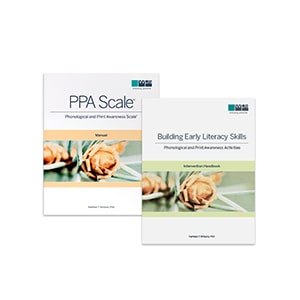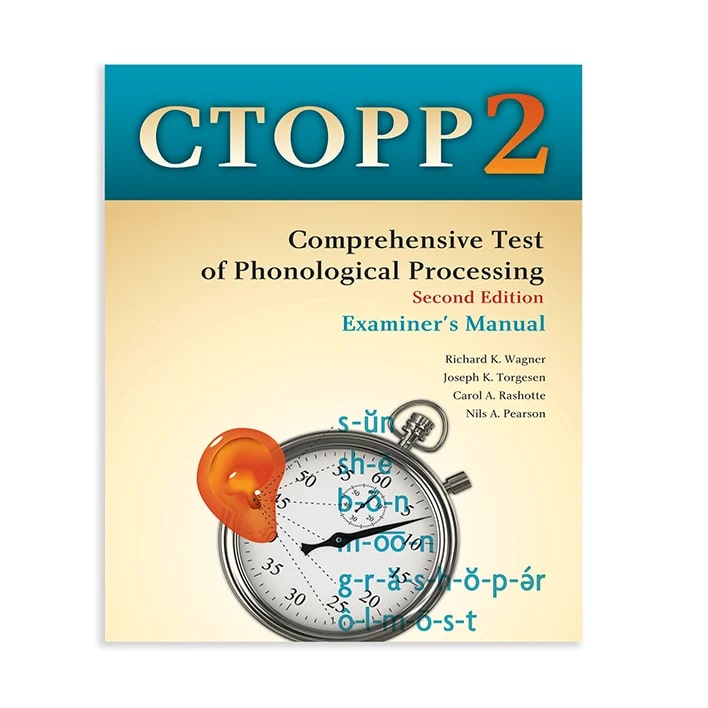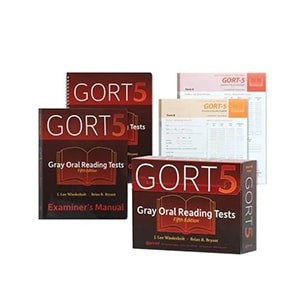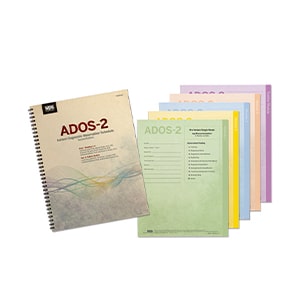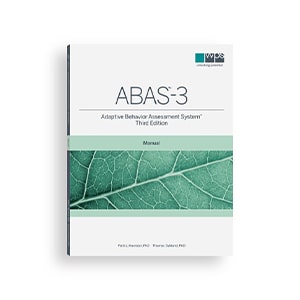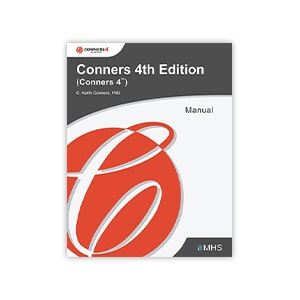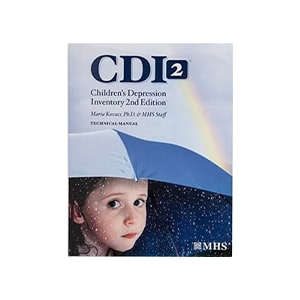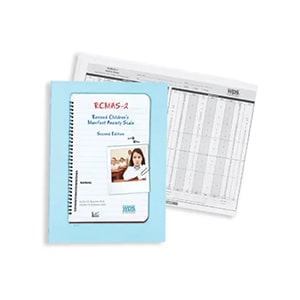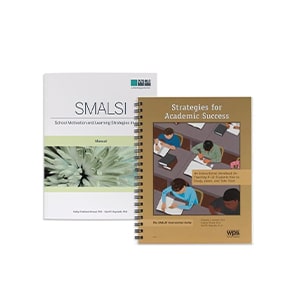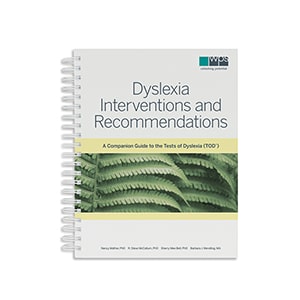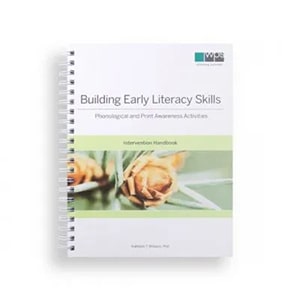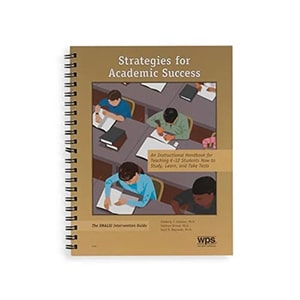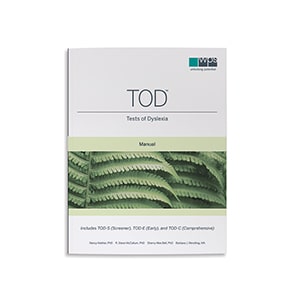
Dyslexia Assessment Best Practices, Resources, and Guidance
We’re pleased to share this Dyslexia Assessment Tool Kit with you.
It’s filled with expert guidance, best practices, and assessment options to help you identify dyslexia and support your students as they build one of the most important skills they will ever learn: reading.
For 75 years, Western Psychological Services (WPS) has partnered with researchers and practitioners to develop assessments that change people’s lives for the better. This year, we’re happy to introduce the Tests of Dyslexia (TOD®), authored by Nancy Mather, PhD; R. Steve McCallum, PhD; Sherry Mee Bell, PhD; and Barbara Wendling, MA. The TOD is the first comprehensive dyslexia assessment complete with a screener, dyslexia-specific early and comprehensive assessments, co-normed rating scales, and a companion guide with evidence-based interventions and recommendations. It’s designed to work with a variety of Specific Learning Disability (SLD) models.
Whether you’re using the TOD or other assessments in your evaluation, we hope the resources in this tool kit will enhance your skills, build your confidence, and equip you to see your students more clearly.
At WPS, we see you and the powerful work you do in clinics, classrooms, and other settings every day. We’re here to support you on every step of your professional journey.
Table of Contents
The Path to Identifying Dyslexia
Identifying dyslexia is a little like following a footpath: With each step, you learn something new—about your student and about the landscape of dyslexia as that student experiences it.
Identifying dyslexia is not about reaching a single destination, because students—and their abilities—transform again and again. Instead, it’s about careful observation, skillful mapping, and learning to change course when necessary.
Let’s get this journey underway.
Start by Defining Dyslexia.
The first step is to understand that the definition of dyslexia can vary depending on the purpose of an evaluation. If you’re assessing eligibility for services in a school setting, the criteria set by the Individuals with Disabilities Education Act (IDEA) and your state Department of Education must be considered.
On the other hand, identifying dyslexia to qualify for workplace disability accommodations may involve medical diagnostic criteria. Understanding each person’s goals will make it clear how you need to proceed.
Examples of Dyslexia Definitions
|
International Dyslexia Association |
“Dyslexia is a specific learning disability that is neurobiological in origin. It is characterized by difficulties with accurate and/or fluent word recognition and by poor spelling and decoding abilities. These difficulties typically result from a deficit in the phonological component of language that is often unexpected in relation to other cognitive abilities and the provision of effective classroom instruction. Secondary consequences may include problems in reading comprehension and reduced reading experience that can impede growth of vocabulary and background knowledge.” |
|
ICD-11: Developmental Learning Disorder with Impairment in Reading |
“Developmental learning disorder with impairment in reading is characterized by significant and persistent difficulties in learning academic skills related to reading, such as word reading accuracy, reading fluency, and reading comprehension. The individual’s performance in reading is markedly below what would be expected for chronological age and level of intellectual functioning and results in significant impairment in the individual’s academic or occupational functioning.” |
|
DSM-5-TR: Specific Learning Disorder with Impairment in Reading |
“Dyslexia is an alternative term used to refer to a pattern of learning difficulties characterized by problems with accurate or fluent word recognition, poor decoding, and poor spelling abilities.” Symptoms persist at least six months despite targeted interventions. |
|
Individuals with Disabilities Education Act (IDEA): Specific Learning Disability |
“Specific learning disability means a disorder in one or more of the basic psychological processes involved in understanding or in using language, spoken or written, that may manifest itself in an imperfect ability to listen, think, speak, read, write, spell, or to do mathematical calculations, including such conditions as…dyslexia.” |
Notice Early Signs.
When a preschool student has delays or difficulties with these skills, it’s time to take a closer look:
In grade-school students, these issues can be signs of dyslexia:
 |
 |
 |
 |
 |
Click here to read more about dyslexia symptoms age by age. Or to download the infographic, click here.
Share Knowledge and Expertise.
To identify dyslexia and plan interventions, people in many different roles need to work together—each person sharing a unique perspective and an important set of skills.
School district guidelines and private practice policies may determine the contributions of people in different roles. Other factors may also influence who administers which tests. To sort out assignments and responsibilities, your team may ask questions like these:
- Which team member is trained in each assessment?
- Which team member has the necessary expertise in a particular area?
- Who has the strongest rapport with the student?
- Who has developed a strong relationship with the family or caregivers?
- How can team members best share the workload?
Every evaluation team looks a little different. Here’s a look at how different roles can function in a comprehensive dyslexia evaluation. As you review the roles described below, consider how teams collaborate in your situation.
Classroom Teacher
Your day-to-day knowledge of a child’s reading ability is central to the diagnostic process—because you are likely to have the most direct contact with the student. You’re listening as the child reads aloud in class. You’re often the first to see assignments that show difficulties with spelling or comprehension. You witness the anxiety, avoidance, and frustration firsthand.
You also provide some of the most compelling evidence—in the form of curriculum-based assessments and work products—to demonstrate what the child can do and where the gaps exist.
Your relationship with parents, students, and caregivers can strengthen their ability to trust the process. You communicate with those at home, informing them of progress, stumbling blocks, and course changes.
Perhaps most important, you carry out the evidence-based instruction that will help this student learn to read. Your knowledge of the Science of Reading and the student’s strengths and needs makes all the difference.
Special Educator
Your knowledge of reading and dyslexia assessments, along with your skill in selecting the right assessment tools for each child, forms the basis of a comprehensive evaluation. Your ability to analyze how a student performs—not only on assessments, but on daily measures—helps create a complete picture of the child. The data you gather at each phase of the journey will help instructors plan and students grow.
When you understand the challenges presented by disabilities, you and your colleagues create equitable testing environments. Your awareness of each student’s culture, language, and personal history will help the team create spaces where all students feel safe and valued as they learn.
You collaborate with the whole team in planning for the student, so that families and students can see that their priorities, concerns, and goals are part of the intervention plan. And for many students, you become a trusted coach and instructor who provides explicit, strategic reading instruction.
Educational Diagnostician
Your knowledge of learning disabilities equips you to spot the signs of dyslexia and distinguish them from the symptoms of other conditions that can lead to reading difficulties and behavior issues.
Your training enables you to select the most useful validated assessments for each situation. And you know how to create a testing environment that is fair and equitable for every student. You consider co-morbidities, overlapping symptoms, personal and educational histories, and the many sequelae of learning disabilities. When testing is complete, you add your observations to those of the other team members to form a full picture of the student at the center of the evaluation.
Equipped with this rich trove of data, you provide an accurate diagnosis. You work with your colleagues to design an intervention plan that amplifies strengths and meets needs. You communicate with students, families, caregivers, and the rest of the dyslexia team to monitor progress throughout the journey.
School Psychologist
You may be among the first to spot dyslexia risk, especially if you’re reviewing data from universal screening in your school. You partner with other educators to review schoolwide scores and identify which students seem to need extra evaluation. Sometimes you’re the one who recognizes the reading problem underneath the behavior issues attracting so much attention. You are in the unique position to reach out to a student and offer help.
You may be the first to say the word “dyslexia” to students and families—which means you may also be first to offer support and guidance. It may be you who talks everyone through the process, explaining who is responsible for each step and answering the many questions that inevitably arise.
You may also work hand in hand with other members of the dyslexia team to be sure that intervention plans are documented, implemented, updated, and communicated. There is almost no part of the dyslexia journey you do not touch.
Reading Specialist
Every reader and teacher in the school—that’s who you serve. You work with administrators to ensure teachers have the evidence-based materials, time, and professional development needed to provide excellent reading instruction.
You support teachers in planning and delivering lessons grounded in the Science of Reading. You expand your colleagues’ knowledge of effective teaching practices.
In addition to coaching, you teach. You work with students who need extra instruction and support. Based on what you observe, you may recommend an evaluation. Because you’re highly trained in reading assessment, you can interpret test results and identify specific skills to address.
The information you share with families, students, and colleagues helps everyone understand the student and the plan. You’re uniquely positioned to influence instruction, motivate students, and keep families informed about growth.
Speech–Language Pathologist
Dyslexia is a complex condition, and diagnosing it takes time and skill. On an evaluation team, your training is invaluable. It enables you to assess the full range of a student’s language skills, including reading, listening, speaking, and writing.
Through careful assessment, you can help determine which language skills may be delayed or impaired, thus illuminating the nature of reading difficulties. The information you provide can help clarify whether a student has dyslexia or another condition that affects reading and literacy.
Your training and cultural competence enhance the team’s ability to meet the needs of English learners. You are skilled in distinguishing language disorders from other factors, such as linguistic and socioeconomic differences.
Through targeted language interventions, you can help a student develop vocabulary, literacy, and reading skills—and you’re instrumental in helping parents and caregivers foster reading development at home.
Occupational Therapist
On an evaluation team, your skill in administering universal screeners and standardized assessments is vital. Dyslexia and reading tests are only the beginning. You can also assess many common co-morbidities such as ADHD and autism, along with conditions that can complicate dyslexia interventions, such as sensory processing differences, executive dysfunction, and other learning disabilities.
Your ability to analyze and adapt environments can help teachers and reading specialists create classrooms and activities that promote engagement and learning. You may be able to recommend assistive technologies that make learning to read simpler. You’re trained to help students achieve their functional and academic goals.
How does a student function at school and at home in light of the challenges dyslexia presents? How do handwriting and letter-formation fit into the intervention plan? How has dyslexia affected the student’s self-concept? And how can a student stay motivated, engaged, and organized throughout the school year? These are questions an occupational therapist is uniquely qualified to explore.
Throughout the dyslexia journey, your skill in problem-solving informs each decision. And your direct involvement in skill building facilitates each student’s long-term success.
The Role of Students, Parents, and Caregivers
The lived experience of each student, parent, and caregiver is central to this journey. Their perspectives and priorities can inform the diagnostic process and the intervention plan. As a clinician or educator, you have an opportunity to
- learn about any family history of reading or academic difficulties;
- find out about medical conditions that may be shaping a student’s experience;
- discuss the student’s language development, academic history, reading or homework practices at home, and other relevant information;
- practice cultural humility in learning about each family’s background and perceptions;
- educate students and families about the diagnostic process and the nature of dyslexia;
- listen to each person’s goals and priorities while planning interventions; and
- keep everyone informed and involved as planning and progress monitoring take place.
Take a Full-Journey Approach.
Dyslexia is a lifelong condition. Even so, decades of research show that people with dyslexia can
- learn to read;
- succeed in school and on the job; and
- manage dyslexia symptoms.
Identifying dyslexia isn’t a one-and-done event. The full journey looks like this: Screen. Assess. Intervene. Monitor and adapt. To reach the best outcomes, start early and support students each step of the way.
For more specific guidance in planning your dyslexia assessment journey, reach out to a WPS Assessment Consultant in your area.

Screen.

Universal screening helps identify students at risk for dyslexia. Screeners are quick, targeted measures designed to reveal reading difficulties and the risk of dyslexia.
Build a Comprehensive Strategy.
Screening is vital, because it allows you to begin early interventions for students with reading difficulties—even if dyslexia isn’t the cause.
But screening isn’t an isolated event.
It should be part of a comprehensive plan designed by a team of professionals—one that can include teachers, special educators, reading specialists, diagnosticians, speech–language pathologists, school psychologists, and other professionals—in partnership with students, families, and caregivers.
As you plan your screening strategy, consider questions like these:
- Who will select and administer the screener?
- Who determines which screeners to use?
- Who decides what the cut scores should be?
- Who sets the course of action when a student is found to be at risk for dyslexia?
- How will you monitor each student’s progress once interventions begin?
- How can you make it easier to adapt when a student’s needs change?
Select the Best Tool for the Job.
With so many screening tools available, it’s important to choose a dyslexia screener that works in your setting. Dyslexia screeners should:
- assess all the skills that enable a student to learn to read;
- be validated for identifying dyslexia risk;
- include students in the normative sample who are representative of the populations you serve; and
- be simple to use with easy-to-understand results.
WPS offers these tools to help you screen for dyslexia risk:
Tests of Dyslexia–Screener (TOD®-S)
The Tests of Dyslexia–Screener (TOD-S) provides a Dyslexia Risk Index score in 10–15 minutes. It can be administered individually or in a group format by teachers and other professionals. The TOD-S features three targeted tests:
Picture Vocabulary. The TOD-S Picture Vocabulary test measures a student’s receptive vocabulary, or their understanding of words they hear or read. When scores on the Picture Vocabulary test are higher than other screening tests, it’s important to take a closer look. That’s because students with dyslexia often have an oral vocabulary that is more highly developed than their reading or spelling skills.
Letter and Word Choice. The TOD-S Letter and Word Choice test measures how well a student recognizes letters and spells words. Difficulty with these tasks may mean a student has trouble with phonemic awareness, orthographic mapping, or other skills that are critical to building the ability to read.
Reading Fluency. The TOD-S Reading Fluency test measures how efficiently students read. Test A is a word-reading test with a 2-minute time limit, intended for kindergarten and 1st Grade. Test B is a question-reading test with a 3-minute time limit, intended for Grades 2 and up. Slow and effortful reading is a key indicator of dyslexia risk.
Assess
As you begin a full dyslexia evaluation for students at risk for dyslexia, your team may want to keep these best practices in mind.
Know the Risk Factors.
In an evaluation, it’s a good idea to explore factors that may increase the likelihood that reading problems stem from dyslexia.
Genes
Dyslexia has been linked to genetic background, and it often runs in families. When you’re evaluating students at risk for the condition, it’s important to ask caregivers and families about reading difficulties, dyslexia diagnoses, learning disabilities, and academic problems that other family members may have experienced.
Linguistics
Differences in early oral language development have been linked to later difficulties with learning to read and spell. In one 2022 study, for example, Finnish researchers found that babies and toddlers with a family history of dyslexia responded to changes in speech sounds differently than those without familial dyslexia (Virtala et al., 2022).
Some early language delays may resolve on their own, but their presence can sometimes predict the development of dyslexia. That’s why it’s vital to explore these skills in a dyslexia evaluation:
- phonemic awareness
- rapid automatized naming
- processing speed
- working memory
- visual–verbal paired associate learning
WPS offers powerful assessments to help you identify language needs and differentiate between dyslexia and language or communication disorders.
Assess All Reading Skills.
To correctly identify dyslexia, the International Dyslexia Association recommends that you assess these skill areas:
|
Best Practice Tip: Begin with the easiest skills and move to more challenging ones. This process will help you pinpoint exactly where instruction should be targeted. For young students, you may want to begin assessments with pictures. |
WPS offers a wide range of trusted reading and dyslexia assessments that can be used flexibly to meet the assessment needs of individual students and whole classes.
Tests of Dyslexia—Early (TOD®-E) and Tests of Dyslexia—Comprehensive (TOD®-C)
The Tests of Dyslexia—Early (TOD-E) can be used as early as kindergarten (age 5) to Grade 2 (up to 9 years 3 months) to obtain a student’s Early Dyslexia Diagnostic Index (EDDI). The Tests of Dyslexia—Comprehensive (TOD-C) provides a Dyslexia Diagnostic Index (DDI) for individuals in Grade 1 (age 6) through adulthood (89 years, 11 months). The TOD-E and TOD-C have age-based and grade-based norms, as well as standard scores and growth scores for measuring progress.
The TOD assesses each area recommended by the International Dyslexia Association, including spelling, reasoning, vocabulary, fluency, phonics, decoding, basic reading, sight word acquisition, phonological awareness, orthographic processing, working memory, rapid automatized naming, comprehension, and visual–verbal paired associate learning.
Learn more about the first comprehensive dyslexia assessment in this video presentation.
Check for Co-Occurring Conditions.
It’s possible for people to have more than one health or neurodevelopmental condition at the same time. These conditions sometimes overlap with dyslexia:
- attention-deficit/hyperactivity disorder (ADHD)
- other specific learning disorders (SLDs)
- developmental language disorder (DLD)
- oppositional defiant disorder (ODD)
- conduct disorder (CD)
- autism spectrum disorder (ASD)
Dyslexia can occur in any population, so it’s crucial to determine whether a reading problem is the result of dyslexia or is related to a health condition, disability, mental illness, or neurodevelopmental difference.
Questions like these can help you make that determination:
- When symptoms of another condition are managed, do reading skills improve?
- Do fluency and accuracy difficulties stem from attention or word-reading issues?
- Is there an underlying oral language impairment?
- Does a student have trouble with comprehension because of word-reading difficulties?
- Are side effects from a student’s medication interfering with reading abilities?
- Do behavior problems happen mainly during reading or academic tasks?
- When did behavior problems begin?
- Are auditory processing, verbal working memory, or processing speed affected?
- Could contextual factors such as lack of instruction, home environment, culture differences, or language learning explain reading difficulties?
For a more detailed look at ways to distinguish between co-occurring conditions, read What to Know About Dyslexia’s Co-Morbidities.
Your team may find these tools helpful for identifying autism, ADHD, and language disorders.
Determine the Nature of Spelling Difficulties.
If spelling is affected by a phonological deficit, you’re likely to notice that the student
- doesn’t put phonemes in the right order,
- adds or leaves out some phonemes, or
- mixes up similar consonant sounds and vowel sounds.
With spelling difficulties that are orthographic in nature, a student may
- organize the phonemes correctly but use the wrong graphemes,
- reverse letter shapes,
- transpose words, or
- spell common words according to their sounds (Mather, 2022)
When you’ve taken the time to observe each child’s pattern of strengths and needs, your team will be better able to map an instructional strategy that makes sense for that individual.
Assess Emotional Effects.
Dyslexia can lead to anxiety, depression, and a loss of self-esteem for some students. As you’re planning an evaluation and intervention strategy, it’s a good idea to assess the emotional impacts your student may be experiencing (Ihbour et al., 2021).
WPS offers a range of tools to help you assess anxiety, depression, and self-concept.
Address the Potential for Implicit Bias.
Human beings in all professions develop assumptions, beliefs, and biases. These mental “shortcuts” are often based on stereotypes, some of which we may not realize are part of our thinking. Biases can
- shape our expectations;
- influence our professional judgment;
- change how we perceive the behavior of others;
- affect how we communicate with stakeholders; and, most importantly,
- lead to unequal treatment of the people in our care.
Examples of implicit bias at work in dyslexia identification:
Male students tend to be over-referred for dyslexia assessment. Some researchers think classroom behavior may play a larger role than reading difficulties in these referrals (Knight & Crick, 2021).
Data on second-grade students in 126 U.S. schools showed dyslexia is less likely to be identified in minoritized students, even when dyslexia screeners show they have the behavioral characteristics of dyslexia (Odegard et al., 2020).
As you plan evaluations, aim to eliminate these types of bias:
- construct bias, by ensuring that you measure the same indicators of dyslexia across all cultural identity groups;
- method bias, by ensuring that you carefully consider testing environments, materials, and procedures; and
- item bias, by ensuring that test items can be understood by students of different cultures, languages, education, and income levels (Verpalen et al., 2018).
It isn’t easy to identify and address biases. It can be even more challenging to eliminate them in institutional processes, policies, and systems. But doing so leads to more reliable evaluation results for students.
Intervene.
Fifty years of research confirms that effective interventions for dyslexia and other specific learning disorders have three common elements:
- They’re explicit. Every student needs explicit reading instruction. That’s because reading is not a skill we acquire naturally or instinctively. For students with dyslexia, systematic, evidence-based instruction is even more important.
- They’re individualized. Which interventions and accommodations a student needs should be based on data from diagnostic and progress-monitoring assessments.
- They’re comprehensive. An intervention plan addresses the full range of reading skills as well as any co-occurring conditions (Grigorenko et al., 2021).
Another principle that researchers can agree on: The earlier interventions begin, the better outcomes are likely to be. Here’s what experts have shared about how to intervene with students who have reading difficulties.
Adopt a Structured Literacy Approach. 
“Structured literacy’” is a phrase coined in 2019 by the International Dyslexia Association. It refers to the practice of clearly and strategically teaching
- phonology (speech and language sounds);
- orthography (writing and spelling patterns);
- syntax (sentence structures);
- morphology (word parts);
- semantics (word relationships); and
- higher-level skills such as comprehension and composition.
In classrooms where structured literacy is taking place, teachers explain and model
- how sounds (phonemes) pair with letters (graphemes);
- how words are decoded and spelled;
- how sounds can be blended, segmented, and manipulated;
- how complex words can be built from smaller units of meaning (morphemes); and
- how words can be organized into sentences.
Teachers track what students are learning, monitoring their progress and adjusting instruction in response to learning.
In structured literacy settings, students
- have lots of opportunities to practice foundational skills;
- use hands-on methods;
- receive specific feedback when they make a mistake;
- interact with lots of different texts; and
- learn one skill before moving to the next in sequence.
Structured literacy is for everyone. And it’s especially important for those with dyslexia.
Click infographic on the right to see at full size.
Share the infographic on your site:
Address Spelling Skills Directly.
In addition to direct instruction in the components of reading, students with dyslexia need explicit spelling instruction.
At first, effective spelling instruction focuses on writing each sound in a word in the right order. When this skill is solidly in place, teachers can address spelling patterns and rules. It’s important that students with dyslexia take all the time they need to learn the spelling of irregular words and to practice with multiple modalities such as tracing and speaking aloud, in addition to seeing and writing.
Be prepared to individualize instruction so each student focuses on the words and patterns that present the biggest challenge for them. The authors of the TOD recommend at least 60–75 minutes of direct spelling instruction each week.
A detailed guide to teaching spelling rules and patterns, including activities, strategies, and technologies, is included in the Dyslexia Interventions and Recommendations: A Companion Guide to the Tests of Dyslexia (TOD).
Provide Individualized Accommodations.
Making sure each student has the accommodations they need isn’t simply a good, evidence-based practice—it’s a legal requirement in most states.
What should accommodations look like for students with dyslexia? Most of the time, accommodations offer alternatives to:
- the ways students access information
- the ways students show what they have learned
- the environment in which a student learns
- the timing of tests and assignments
Planning accommodations should be teamwork: educators, specialists, students, and caregivers. Here are a few to consider. Educators can
- incorporate technology that helps to compensate for dyslexia;
- add extra time to assignments and assessments;
- provide organizational aids and visual supports;
- assist with read-aloud options; and
- allow students to present information in ways that are less dependent on writing.
Many WPS assessments offer evidence-based intervention recommendations aligned with the strengths and needs revealed by a student’s performance on test items. This time-saving guidance helps educators individualize instruction, interventions, and accommodations based on each student’s data.
Here’s a look at a few such tools.
Monitor and Adapt.
The International Dyslexia Association’s Knowledge and Practice Standards for Teachers of Reading encourages educators to
- understand how to use assessments to monitor a student’s progress;
- link information from progress-monitoring assessments to decisions about what, how, and how fast to teach; and
- share progress with caregivers, colleagues, and students in a way they can understand.
Know the Difference: Monitoring Progress vs. Progress Monitoring.
Teachers keep an eye on student progress every day in the classroom. With each activity and assessment, teachers evaluate what students produce and they make immediate instructional decisions based on what students can and can’t yet do.
Monitoring progress in this way helps teachers understand which instructional strategies are working and which might need to be changed (Miciak & Fletcher, 2020). The measures a teacher uses to monitor progress in the classroom usually aren’t standardized, and they’re generally given to all students to check for understanding.
Formal progress monitoring differs in some important ways.
Practice Formal Progress Monitoring.
Progress monitoring is the use of quick, easy-to-administer assessments to measure student growth over time. Formal progress monitoring focuses on students who are receiving interventions, either because they have reading difficulties or they have a higher risk of dyslexia.
The National Center on Intensive Intervention recommends that educational teams
- select standardized, validated tools that are sensitive to change;
- repeat progress-monitoring assessments as often as monthly for Tier 2 students and weekly for Tier 3 students;
- graph student progress, including baseline data, goals, and trend lines;
- use data for instruction, intervention, and eligibility decisions; and
- communicate student progress data to caregivers and intervention teams.
|
Best Practice Tip: When you give progress-monitoring assessments, it’s important to keep as many factors the same as possible so that the data accurately reflect a student’s progress rather than some other condition. Choose the same assessment. When, where, and how you test should also stay the same—right down to the instructions and guidance you provide. |
WPS is pleased to offer these tools to help you track student growth, evaluate the effectiveness of instruction, and measure response to interventions.
A Guide to Pacing Yourself
Walking a student through dyslexia diagnostics and interventions can be rigorous and challenging. Gains aren’t guaranteed, and progress isn’t always smooth and linear. But a more worthwhile journey is hard to imagine. So, here’s our best advice for how to pace yourself.
Start Early.
Identifying dyslexia in kindergarten, Grade 1, or Grade 2 and following up with intensive, quality interventions can lower dyslexia risk in the long run. In some studies, the risk dropped from 20% to below 5% for students who received excellent instruction. That’s not to say gains can’t be had if interventions begin in Grade 3 or later—but progress may be slower (Fletcher et al., 2021).
Use a Comprehensive Model.
Identifying dyslexia takes time and a range of assessments. You’ll need quantitative as well as qualitative data from as many sources as possible. That’s because diagnoses that rely on a single indicator are often less reliable and more likely to involve measurement error than those which incorporate several kinds of information. Researchers recommend considering reading difficulties, limited response to intervention, and high cumulative risk factors in your evaluation (Wagner et al., 2019).
Collaborate.
Planning an assessment strategy—whether it’s for an individual student or an entire school district—is most effective when professionals with different skillsets and perspectives work together. There’s no need to go it alone. In an ideal setting, a multidisciplinary team is “useful in the holistic evaluation and management” of learning disorders, researchers say (Shah et al., 2019).
Communicate with Engagement in Mind.
Talking about dyslexia with parents, caregivers, and students requires a careful balance of straightforward, clear language and sensitivity. It’s important to minimize jargon, to establish clear responsibilities and timelines, and to listen with cultural humility to the needs of everyone in the room.
Give Yourself Permission to Learn.
Research on dyslexia and the Science of Reading is always expanding, and assessments are continuously being updated and improved. It’s important to take advantage of professional development and training opportunities available to you.
WPS is pleased to offer a series of free, on-demand dyslexia webinars that take a deeper look at the condition, the diagnostic process, and evidence-based interventions. You can view them here.
Onward
We hope this Dyslexia Assessment Tool Kit has given you a clearer picture of the diagnostic, intervention, and progress-monitoring tools available to you and your team.
When you’re ready for next steps, we invite you to speak with a WPS Assessment Consultant in your area. WPS Assessment Consultants are seasoned educators and clinicians. They’re ready to help you map a dyslexia assessment journey that takes you and your students where you need to go.
Research and Resources:
Dymock, S., & Nicholson, T. (2023). Dyslexia seen through the eyes of teachers: An exploratory survey. Reading Research Quarterly. https://doi.org/10.1002/rrq.490
Fletcher, J. M., Francis, D. J., Foorman, B. R., & Schatschneider, C. (2021). Early detection of dyslexia risk: Development of brief, teacher-administered screens. Learning Disability Quarterly, 44(3), 145–157. https://doi.org/10.1177/0731948720931870
Grigorenko, E. L., Compton, D. L., Fuchs, L. S., Wagner, R. K., Willcutt, E. G., & Fletcher, J. M. (2020). Understanding, educating, and supporting children with specific learning disabilities: 50 years of science and practice. The American Psychologist, 75(1), 37–51. https://doi.org/10.1037/amp0000452
Hulme, C., & Snowling, M. J. (2016). Reading disorders and dyslexia. Current Opinion in Pediatrics, 28(6), 731–735. https://doi.org/10.1097/MOP.0000000000000411
Ihbour, S., Anarghou, H., Boulhana, A., Najimi, M., & Chigr, F. (2021). Mental health among students with neurodevelopment disorders: Case of dyslexic children and adolescents. Dementia & Neuropsychologia, 15(4), 533–540. https://doi.org/10.1590/1980-57642021dn15-040014
International Dyslexia Association. (2019). Structured literacy: An introductory guide. Baltimore, MD: Author. (2018). Knowledge and practice standards for teachers of reading. https://dyslexiaida.org/knowledge-and-practices/
Knight, C., & Crick, T. (2021). The assignment and distribution of the dyslexia label: Using the UK Millennium Cohort Study to investigate the socio-demographic predictors of the dyslexia label in England and Wales. PloS One, 16(8), e0256114. https://doi.org/10.1371/journal.pone.0256114
Mather, N. (2022). Best practices in dyslexia assessment. https://pages.wpspublish.com/webinars
Miciak, J., & Fletcher, J. M. (2020). The critical role of instructional response for identifying dyslexia and other learning disabilities. Journal of Learning Disabilities, 53(5), 343–353. https://doi.org/10.1177/0022219420906801
Moats L. (2019). Structured literacy™: Effective instruction for students with dyslexia and related reading difficulties. Perspectives on Language and Literacy. https://app.box.com/s/d0f0z903gkcreh2ewdtnunln4lyxhezi
National Center for Intensive Intervention. (n.d.) Progress monitoring. https://intensiveintervention.org/data-based-individualization/progress-monitoring
Odegard, T., Farris, E., Rimrodt-Frierson, S., Middleton, A., Oslund, E. (2020). Characteristics of students identified with dyslexia within the context of state legislation. Journal of Learning Disabilities, 53(5), 366-379. https://journals.sagepub.com/doi/10.1177/0022219420914551
Rawan, D. (n.d.). My truth about dyslexia―What I wish for other kids with dyslexia and their parents. https://sites.ed.gov/osers/2018/10/my-truth-about-dyslexia/
Serry, T., Snow, P., Hammond, L., McLean, E., & McCormack, J. (2022). Educators’ perspectives about teaching and supporting students with reading difficulties. Australian Council for Education, 66(3). https://journals.sagepub.com/doi/epub/10.1177/00049441221130551
Shah, H. R., Sagar, J. K. V., Somaiya, M. P., & Nagpal, J. K. (2019). Clinical practice guidelines on assessment and management of specific learning disorders. Indian Journal of Psychiatry, 61(Suppl 2), 211–225. https://doi.org/10.4103/psychiatry.IndianJPsychiatry_564_18
Verpalen, A., Van de Vijver, F., & Backus, A. (2018). Bias in dyslexia screening in a Dutch multicultural population. Annals of Dyslexia, 68(1), 43–68. https://doi.org/10.1007/s11881-018-0155-0
Virtala, P., Putkinen, V., Kailaheimo-Lönnqvist, L., Thiede, A., Partanen, E. & Kujala, T. (2022). Infancy and early childhood maturation of neural auditory change detection and its associations to familial dyslexia risk. Clinical Neurophysiology, 137(159). https://doi.org/10.1016/j.clinph.2022.03.005
Wagner, R. K., Edwards, A. A., Malkowski, A., Schatschneider, C., Joyner, R. E., Wood, S., & Zirps, F. A. (2019). Combining old and new for better understanding and predicting dyslexia. New Directions for Child and Adolescent Development, 2019(165), 11–23. https://doi.org/10.1002/cad.20289
Wilmot, A., Pizzey, H., Leitão, S., Hasking, P., & Boyes, M. (2023). Growing up with dyslexia: Child and parent perspectives on school struggles, self-esteem, and mental health. Dyslexia, 29( 1), 40– 54. https://doi.org/10.1002/dys.1729
Wilmot, A., Pizzey, H., Leitão, S., Hasking, P., & Boyes, M. (2023). “I struggle at times to see her struggle”: Mothers' perspectives on dyslexia-related school struggles and the inter-connected nature of mother and child well-being. Dyslexia, 1– 15. https://doi.org/10.1002/dys.1733
World Health Organization. (February 2022). 6A03.0 Developmental learning disorder with impairment in reading. https://icd.who.int/browse11/l-m/en#/http%3a%2f%2fid.who.int%2ficd%2fentity%2f1008636089



